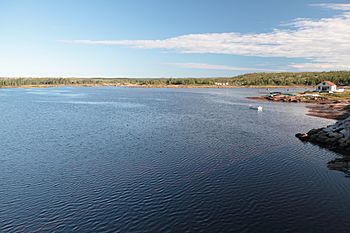Piashti River facts for kids
Quick facts for kids Piashti River |
|
|---|---|

The river mouth from Quebec Route 138
|
|
| Country | Canada |
| Province | Quebec |
| Region | Côte-Nord |
| RCM | Minganie |
| Physical characteristics | |
| River mouth | Gulf of Saint Lawrence 0 metres (0 ft) 50°17′11″N 62°48′19″W / 50.2863889°N 62.8052778°W |
| Length | 20 kilometres (12 mi) |
| Basin features | |
| Basin size | 386 square kilometres (149 sq mi) |
The Piashti River (also known as Rivière Piashti in French) is a special river in the Côte-Nord region of Quebec, Canada. It's famous for its salmon and flows into the big Gulf of Saint Lawrence. This river is important for local wildlife and has a cool history.
Contents
Where is the Piashti River?
The Piashti River flows for about 20 kilometers from Lake Piashti towards the south. It passes through Little Lake Piashti and ends in Johan-Beetz Bay. The area drained by the river is about 386 square kilometers. It sits between the Corneille River to the west and the Quetachou River to the east.
Lake Salé and its Waterfall
About 2 kilometers from where it meets the sea, the river flows into Lake Salé (which means Salt Lake). It does this over a really impressive waterfall! This lake is unique because it gets fresh water from the river. But it also gets salty water from the Saint Lawrence during high tides.
The Village of Baie-Johan-Beetz
The river flows into Johan-Beetz Bay, which is part of the Gulf of Saint Lawrence. This happens in the town of Baie-Johan-Beetz. The village near the river's mouth was started around 1860 by Joseph Tanguay and his wife. They made their living by fishing for salmon. Even today, many people in the village work in fishing and hunting.
In 1918, the village and bay were renamed after a Belgian scientist named Johan Beetz. In 1898, Johan Beetz built a large, beautiful wooden house with 12 rooms. It was built on a rocky spot overlooking the Piashti River. This "doctor's castle" was recognized as a historical building in 1979. There's even a hiking trail from the village that leads to the river's waterfalls.
What's in a Name?
The name "Piashti" first referred only to the bay. Later, it was also used for the river and the lakes. It means "dry bay." This might be because the bay is only deep enough for average boats to enter during high tide.
Old maps show the name changing over time. A map from 1685 by Jean-Baptiste-Louis Franquelin showed "Piastebe." This was a place often visited by the Innu people. In the early 1900s, people sometimes wrote "Rivière Piasthi Bay" or "Rivière Piashbe Bay." By 1914, the Geography Commission used the name "Piashtih" for the bay.
River Features and Surroundings
The Piashti River is like a series of lakes connected by short, fast-flowing sections called rapids. About 5 kilometers from its mouth, there are waterfalls that are about 45 meters high! The area around the river has low mountains and some forests.
In the past, much of the forest here was burned. But now, new trees like white spruce, black spruce, tamarack, and birch are growing back. The river is known for its salmon, especially near the first waterfall. It's also a great place for hunting.
Animals and Nature
The Piashti River valley is a good home for animals like moose (Alces alces). Traces of moose were found here in the late 1970s. Lake Salé has many water plants and is visited by different kinds of seabirds.
A special station for tagging migratory birds used to operate at Lake Salé until 2004. This station once recorded the highest number of green-winged teal (Anas carolinensis) in North America! Other birds you might see here include the merlin (Falco columbarius) and the majestic bald eagle (Haliaeetus leucocephalus).
Fish in the Piashti River
The Piashti River has clear water and a riverbed made of dark gravel and large pebbles. The last 6 kilometers of the river are where Atlantic salmon (Salmo salar) can swim upstream. Other fish found here include brook trout (Salvelinus fontinalis), Arctic char (Salvelinus alpinus), and American eel (Anguilla rostrata).
A company called Baie-Johan-Beetz Outfitter has special rights to fish in Lake Salé and the Piashti River. There are eight spots along the river where people can catch salmon from a boat or by wading in the water.
Protecting Salmon
In 2015, the Quebec government started a special program for sport fishing on some salmon rivers, including the Piashti. For large salmon, anglers had to catch and then release them back into the water. This was done to help protect the salmon population. Some groups, like the Quebec Atlantic Salmon Federation, felt that more needed to be done to protect salmon for the future. They believed that catch-and-release should be used on almost all rivers to help the declining Atlantic salmon numbers.


